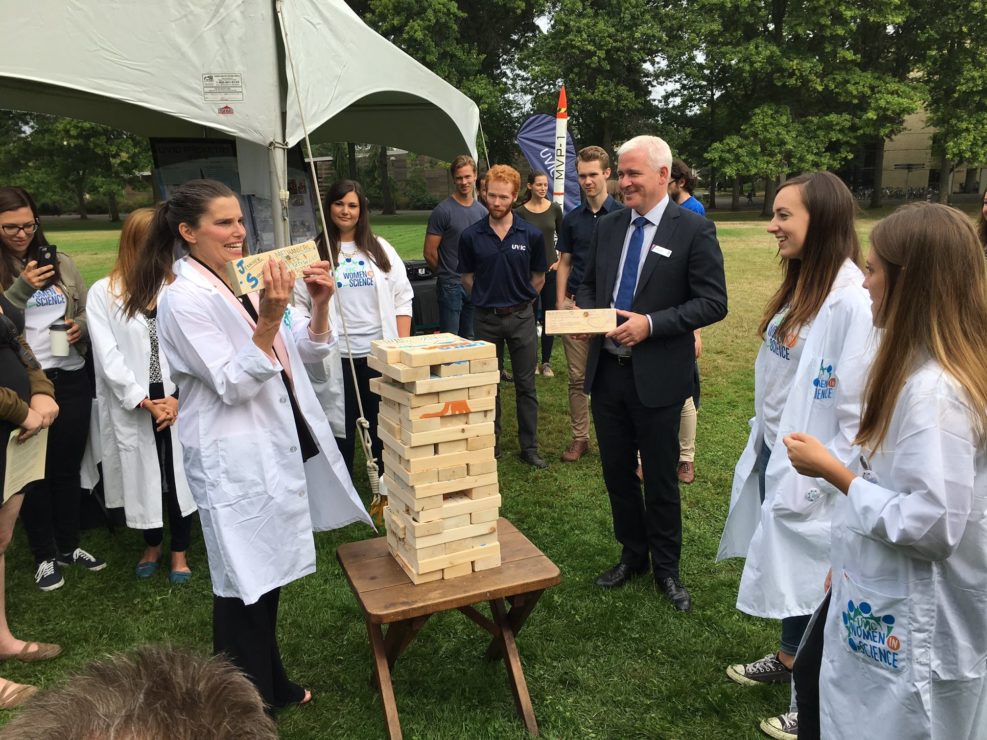Symposiums, workshops, and mentorships all part of Women in Science’s plan to assist women pursuing science or math degrees

It was the addition of heat to cocoa and butter that solidified Chloe Christensen’s desire to pursue science.
From a young age, Christensen has been interested in biology. But in a field dominated by men, it took a middle school experiment to create “armpit fudge” led by a female teacher to open Christensen’s eyes to how complicated science terms could be explained through an interactive medium.
“I always just thought it was really entertaining how she [middle school teacher Sabrina Fonagy] made learning these complex topics interesting,” said Christensen.
At the university level, Christensen was quick to mention UVic Professor Dr. Rossi Marx as a key figure in motivating her to pursue a degree in science through engaging lectures and labs.
“I took a couple courses with [Marx] and I found her really inspiring as well … Just having those core female role models was what really motivated me to go into science.”
After finishing her bachelor of science from UVic in 2015, Christensen entered the graduate program in September of that year and is currently in the third year of a PhD in UVic’s Department of Biology.
Halfway through Christensen’s master’s degree in March of 2017, two former UVic science students, Karen Lithgow and Hannah Charnock, decided to start an on-campus group to help assist female graduate and undergraduate students in STEM (Science, Technology, Engineering, and Mathematics) fields after seeing inequalities in the program.
“They saw this gender disproportion in STEM, and they wanted to do something about it. There’s not a lot of ‘Women in Science’ groups in Canada, so that was what pushed them to co-found this organization,” said Christensen.
The group launched with a March for Science that spring, and then another graduate student introduced Christensen to the Women in Science club, where she decided to volunteer and work her way up to her current role as club president.
The goal of the club, written on their website, is to help create an engaging environment that fosters collaboration and offers support for women pursuing science degrees.
Among the ways to get younger female science students involved, Women in Science has three mottos that serve as cornerstones of the club: acknowledgement, empowerment, and engagement.
Specifically, the club wants to address biases in science-based fields and serve as a facilitator to help break down those barriers and get women scientists a foot in the door of a predominantly male-dominated profession.
A 2017 study from AAUW reported first year male students outnumber the number of first year female students who enter university in engineering, computer science, and physics fields. And while women graduating in bachelor’s degrees in science and engineering fields have increased from 28 to 50 per cent from 1970 to 2013, lowering performing males were still reported to receive preferable hiring treatment over lowering performing women.
“Generally as a club we acknowledge the fact that there are gender biases in STEM, and there’s also biases in pay once you get into the career structure,” said Christensen.
Christensen says, as part of the acknowledgment branch, that Women in Science is in the process of establishing a scholarship to help female students early in their career to make connections and get started as research scientists, or whichever STEM profession they’re interested in pursuing.

Among other networking and panel discussions, UVic Women in Science has hosted a STEM Research Symposium, began engaging with high school students interested in STEM, and launched a peer mentorship program this fall.
Despite the club being a little over two years old, one success story has already emerged from the first symposium last year.
“Anastasia Litke, MSc, UVic graduate, met Dr. Amanda Malone of Eupraxia Pharmaceuticals through Ana’s role as Panel Chair, on which Amanda was a panelist,” Christensen said. “Ana now works as a Research Associate for Amanda.”
Christensen says that is just one example how Women in Science can help female students breakthrough in science and technology central fields.
For the first time last year, the group talked with high school students at St. Margaret’s school for their “Girls’ STEM Leadership Conference” to discuss career paths and what to expect as students and individuals early in their careers in STEM fields.
Meanwhile, in university the new mentorship program helps connect first and second year female students to fourth and fifth years so younger students can learn what to expect in their degree.
“They meet about once a month to talk about suggestions for how to succeed in your particular program, and we’ve matched them up so the mentors did their undergrad in the same area as the mentees,” Christensen said.
Years after Ms. Fonagy helped inspire Christensen to pursue a degree in the field of science through armpit fudge, this UVic student is hoping to do the same with the next generation of female students — minus the cocoa and butter.








